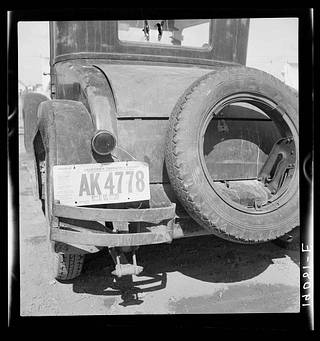
Similar
Temporary auto license. A common sight in migratory labor camps. Many enter California after cotton picking in Arizona without sufficient money to buy license plates. California
Summary
Title and other information from caption card.
Transfer; United States. Office of War Information. Overseas Picture Division. Washington Division; 1944.
More information about the FSA/OWI Collection is available at http://hdl.loc.gov/loc.pnp/pp.fsaowi
Temp. note: usf34batch2
Film copy on SIS roll 27, frame 2398.
The automobile was first invented and perfected in Germany and France in the late 1890s. Americans quickly came to dominate the automotive industry after WWI. Throughout this initial era, the development of automotive technology was rapid. Hundreds of small manufacturers competing to gain the world's attention. Key developments included the electric ignition system, independent suspension, and four-wheel brakes. Transmissions and throttle controls were widely adopted and safety glass also made its debut. Henry Ford perfected mass-production techniques, and Ford, General Motors, and Chrysler emerged as the “Big Three” auto companies by the 1920s. Car manufacturers received enormous orders from the military during World War II, and afterward automobile production in the United States, Europe, and Japan soared.
Born in Hoboken, New Jersey in 1895, Dorothea Lange contracted polio as a young girl. She learned professional photography skills while working in New York in her early 20s, and then landed in San Francisco where she ran a portrait business catering to the city's wealthy elite. Her second husband, Paul Taylor, helped her to get out into the fields with the destitute pickers, who she'd treat like portrait subjects with empathy and identification with her subjects. When the Depression hit, she captured crowded breadlines. In the late 1930s Dorothea Lange had been hired by the photographic unit of the Farm Security Administration - to photograph Dust Bowl refugees escaped into California from the Midwest and her images went far beyond bureaucratic reportage. A skilled portraitist, Lange might not have been able to change government policies, but her images for the FSA were picked up by newspapers across the country. John Steinbeck used them for inspiration in his 1939 Dust Bowl tale "The Grapes of Wrath."
Tags
Date
Location
Source
Copyright info




























